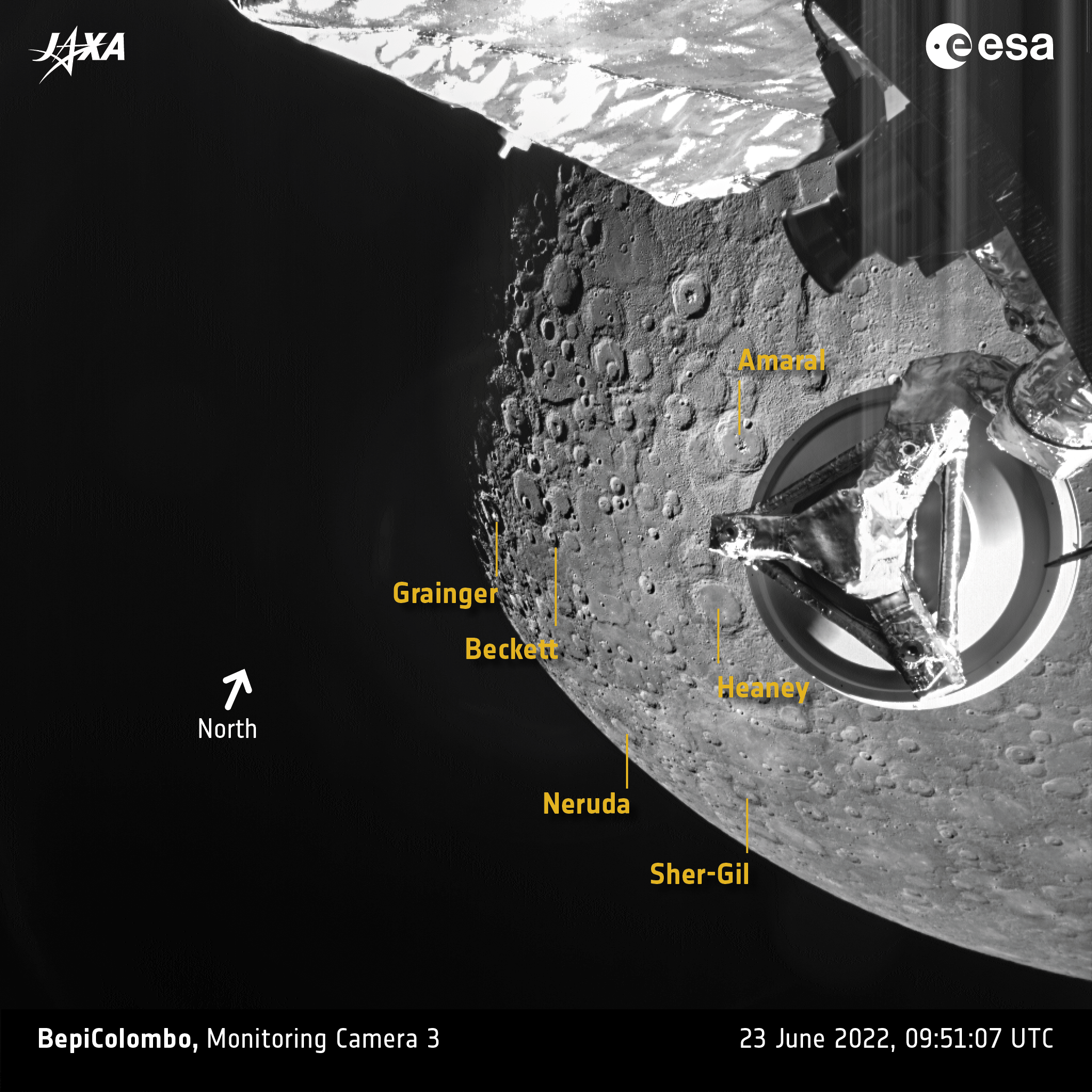Watch Mercury roll by as BepiColombo probe makes superclose flyby (video)
The video reveals a plethora of geological features, including Caloris Planitia, Mercury's largest impact basin.
A new video released by the European Space Agency (ESA) on Monday (June 27) shows the crater-riddled surface of the solar system's smallest planet Mercury as captured during a super close flyby of the BepiColombo spacecraft.
BepiColombo, a joint mission of ESA and the Japan Aerospace Exploration Agency (JAXA), is currently on a seven-year cruise through the inner solar system, using the gravity of planets including Mercury, Venus and Earth to slow down so that it can enter Mercury's orbit in 2025.
The Mercury flyby, which took place on Thursday (June 23), was BepiColombo's second at the scorched, rocky planet that will be its ultimate destination. Just like during the first encounter, which took place on Oct 1, 2021, the probe approached the planet to an extremely close distance of only 120 miles (200 kilometers). That is closer than the two orbiters that comprise the BepiColombo mission will orbit the planet after their arrival.
Related: BepiColombo spacecraft swings past Venus on long road to Mercury

The video released by ESA stitches together 56 images captured by the spacecraft's three low-resolution monitoring cameras over a 15-minute period shortly after the probe's closest approach to the planet. The first image was taken at a distance of 572 miles (920 km), and the sequence ends with BepiColombo 3,790 miles (6,099 km) away from the planet.
Because BepiColombo approached Mercury from the nightside, the spacecraft couldn't photograph the planet at the moment of closest approach. However, other instruments on board of the two orbiters were turned on, measuring solar wind in the vicinity of the spacecraft. The solar wind is a stream of charged particles emitted by the sun that flows across the entire solar system, triggering space weather events on Earth and other planets.
The two orbiters are traveling through space stacked on top of a transfer module, so their high-resolution imagers are hidden and can't be used during the cruise phase.
Get the Space.com Newsletter
Breaking space news, the latest updates on rocket launches, skywatching events and more!
The new images reveal a plethora of geological features including numerous craters, volcanic planes and cliff-like tectonic cracks. Among the craters captured by the spacecraft is Caloris Planitia, the largest impact basin on Mercury and one of the largest in the entire solar system. The 960-mile-wide (1,550 km) crater was created by a giant asteroid at least 60 miles (100 km) in diameter. For comparison, scientists estimate that the Chicxulub asteroid that led to the extinction of dinosaurs some 66 million years ago was only 6 miles (10 km) wide.
BepiColombo is only the second mission in history designed to orbit Mercury and the third to have photographed it. The planet is notoriously difficult to reach because any spacecraft heading into the inner solar system has to constantly brake against the gravitational pull of the sun. Mission engineers therefore mapped a long and winding trajectory that takes it via several celestial bodies, the gravity of which slows down the spacecraft.
NASA's Messenger mission studied Mercury between 2011 and 2015. The probe observed a range of puzzling phenomena, including Mercury's surprising magnetic field and the existence of ice in the shaded craters around the planet's poles. This ice persists in these regions in spite of the fact that temperatures in the sun-exposed parts of the planet can reach merciless 800 degrees Fahrenheit (420 degrees Celsius). BepiColombo is designed to shed more light on the planet's mysteries.
The first probe to have photographed Mercury was NASA's Mariner 10, which made three flybys at the planet in the early 1970s while in orbit around the sun. BepiColombo's next Mercury flyby will take place about one year from now. In the meantime, next month, BepiColombo will make the closest approach it will ever make to the sun.
Follow Tereza Pultarova on Twitter @TerezaPultarova. Follow us on Twitter @Spacedotcom and on Facebook.
Join our Space Forums to keep talking space on the latest missions, night sky and more! And if you have a news tip, correction or comment, let us know at: community@space.com.

Tereza is a London-based science and technology journalist, aspiring fiction writer and amateur gymnast. Originally from Prague, the Czech Republic, she spent the first seven years of her career working as a reporter, script-writer and presenter for various TV programmes of the Czech Public Service Television. She later took a career break to pursue further education and added a Master's in Science from the International Space University, France, to her Bachelor's in Journalism and Master's in Cultural Anthropology from Prague's Charles University. She worked as a reporter at the Engineering and Technology magazine, freelanced for a range of publications including Live Science, Space.com, Professional Engineering, Via Satellite and Space News and served as a maternity cover science editor at the European Space Agency.








